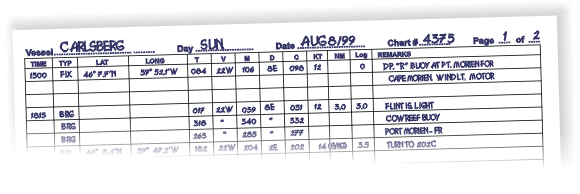|
|
Section 5Plotting Basics |
|
|
Section 5Plotting Basics |
5.4 |
The Logbook |
|
Please note that keeping a log is not part of the CYA Coastal Navigation Standard. Navigators keep track of a lot of things during a cruise: courses, bearings, changes in speed, estimated effects of current and leeway, weather, and fuel usage to name a few. A logbook or log is used to enter information for later referral. |
||
|
Logbooks may vary from notepads to elaborately-bound books with custom-printed pages. Regardless of type, they should permit quick and orderly entries in an easy-to-read format. Legibility ensures that other crew can follow the boat's track and conditions encountered. Commercial vessels are required to keep a log. In the case of an incident, logs may provide evidence in court. There are no hard and fast rules about what goes into a log. Some boaters restrict entries to navigational matters. Certainly anything to do with any urgency — monitoring a "Mayday" call, for example — should be entered in detail. Others use it as more of a journal as well as a log with light-hearted entries such as "We saw seven porpoises today", or "Running low on peanut butter". Entries should allow the passage to be re-traced and events to be re-constructed. |
||
| Pages are usually divided into columns under headings for time, course, speed, and distance traveled. A wider column provides a place for remarks, including weather observations. Pre-formatted logbooks are available at marine supply stores but many boaters prefer to make their own. | ||

|
||
What to IncludeThe logbook provides a record of a journey that can be revisited for facts or fond memories. Here are suggestions as to what should be included:
|
||||||||||||||||||
|
|
Get Help |
|
|
|
|
|
|